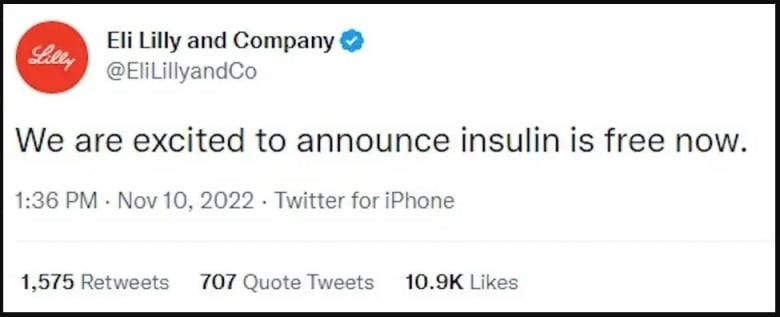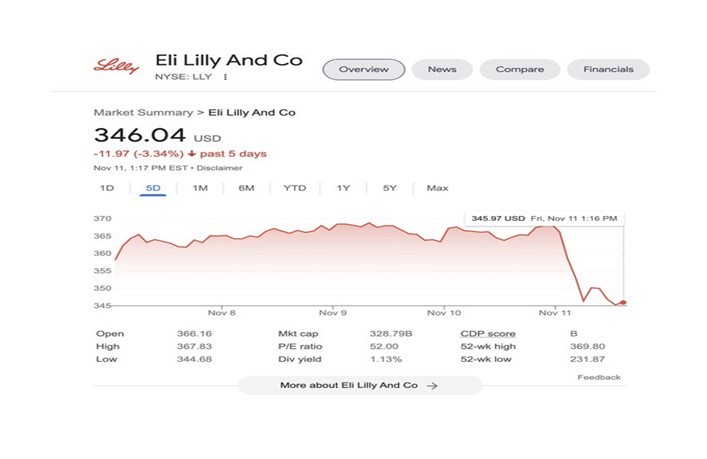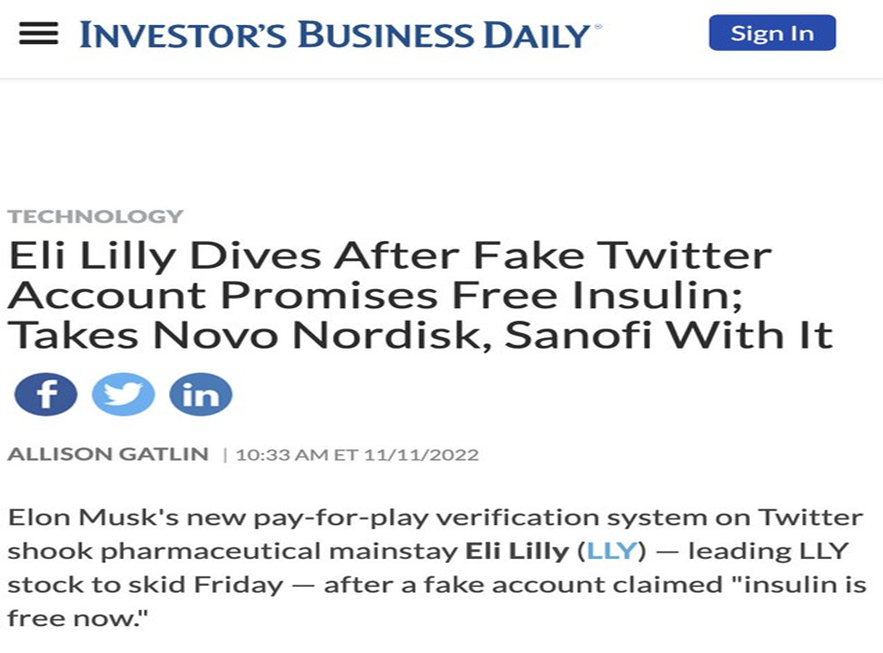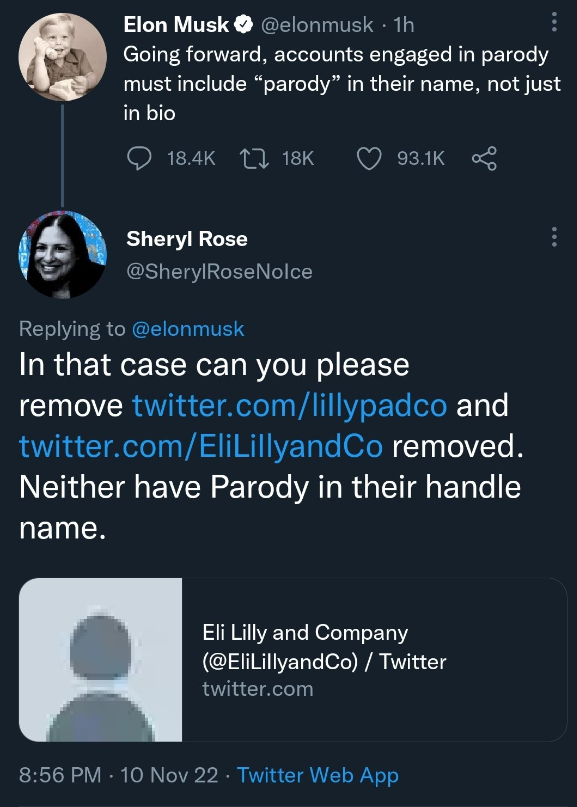In an age where information travels at the speed of light, the influence of social media on public opinion and market dynamics cannot be overstated. A single tweet, a Facebook post, or an Instagram story can rapidly shape perceptions, trigger market movements, and even impact the fate of corporations. The debacle involving pharmaceutical giant Eli Lilly serves as a poignant example of the far-reaching consequences of social media misinformation.
On 10 November 2022, New Yorker Sean Morrow tweeted from a parody Eli Lilly account saying that henceforth, “insulin is free”. This tweet set Twitter ablaze. Despite the swift removal of the tweet hours after it circulated, the fallout saw Eli Lilly’s share price nosedive from US$368.72 to US$352.30 on 11 November.

To Twitter users, the verified @EliLillyandCo account may have appeared authentic due to the presence of the coveted blue checkmark. However, it was actually one of the numerous parody accounts spawned by Elon Musk’s initial $8 Twitter Blue initiative. Its sole intention was to mock a prominent pharmaceutical company, adding to the chaos and confusion surrounding the platform.

It wasn’t until 22 November that Morrow publicly revealed himself as the individual behind the account, doing so through a video shared on his workplace’s Twitter account, More Perfect Union. He elaborated that even in the improbable scenario where the tweet had influenced the stock, it wasn’t due to deception, as “no one genuinely believed” the drug would be offered for free.

However, there was one crucial detail that transformed this narrative from a cautionary tale to a cautionary tale of the digital age—the tweet was a hoax. The purported financial analyst turned out to be an imposter, casting doubts on the credibility of the information disseminated. Yet, despite the swift revelation of the tweet’s falsity, the damage had been done. Eli Lilly suffered significant losses, and the incident underscored the immense power wielded by social media in shaping public opinion and market sentiments.
The pervasiveness of social media platforms has democratised information dissemination, allowing anyone with an internet connection to become a content creator and influencer. While this democratisation fosters transparency and facilitates the exchange of ideas, it also amplifies the spread of misinformation and rumours. In the case of Eli Lilly, the speed at which the false information propagated highlights the inherent risks associated with the unfiltered nature of social media.

Moreover, the incident underscores the delicate balance between the benefits and pitfalls of the digital age. On one hand, social media platforms offer unprecedented opportunities for companies to engage with customers, build brand loyalty, and disseminate information. Conversely, they also expose businesses to heightened scrutiny, viral controversies, and reputational risks.
For Eli Lilly, the episode served as a wake-up call, prompting the company to reassess its crisis communication strategies and vigilantly monitor social media channels for potential threats. Approximately two and a half hours later, the authentic Eli Lilly corporate account issued an apology tweet, expressing regret to those who had encountered a deceptive message from a counterfeit Lilly account. The company confirmed its genuine handle as @Lillypad.
Yet, for all its potential to shape public discourse, social media remains a double-edged sword, capable of inflicting as much harm as it does good. The Eli Lilly saga highlights the need for greater caution and analytical thinking to be exercised in an age where misinformation proliferates unchecked, threatening to undermine trust in institutions and sow discord within society.
Eli Lilly acknowledges the fact that Insulin prices are indeed high
Eli Lilly acknowledges the issue of high prices, conceding that the tweet accomplished Morrow’s intended goal – igniting a dialogue about the exorbitant costs of life-saving medications, particularly insulin, upon which millions of Americans rely.
The incident not only prompted Eli Lilly to clarify that insulin isn’t free, but it also led the pharma behemoth’s CEO David Ricks to acknowledge that the fake tweet debacle underscores the ongoing necessity to lower the cost of insulin for a broader population. According to a press release from 2022, the company prices individual vials of their Insulin Lispro Injection at US$82.41, or US$159.12 for a pack of five pens.
The Rise of Social Media: A Catalyst for Change
The advent of social media has revolutionised the way we communicate, connect, and consume information. Platforms like Twitter, Facebook, Instagram, and LinkedIn have become integral parts of our daily lives, shaping our perceptions, influencing our decisions, and connecting us with a global audience. From sharing personal updates to discussing world events, social media has fundamentally altered the fabric of society, ushering in an era of unprecedented connectivity and accessibility.
The pervasiveness of social media in shaping public opinion cannot be overstated. Platforms like Twitter, Facebook, and Instagram serve as virtual echo chambers, where ideas are amplified, trends are set, and narratives take root with astonishing speed.
For all its pitfalls, social media also holds immense promise as a force for positive change. From galvanising grassroots movements to amplifying marginalised voices, platforms like Twitter and Facebook have emerged as powerful tools for driving social, political, and economic transformation. The same networks that facilitated Eli Lilly’s downfall can also serve as vehicles for corporate transparency, accountability, and engagement, fostering greater trust and collaboration between companies and their stakeholders.

The Eli Lilly incident underscores the potential consequences of the unchecked spread of misinformation on social media. In a matter of minutes, a false tweet triggered a chain reaction that resulted in significant financial losses for the company and undermined investor confidence.
Despite these challenges, social media also presents immense opportunities for businesses to engage with customers, build brand loyalty, and drive sales. Platforms like Instagram and TikTok offer new avenues for companies to showcase their products, connect with influencers, and reach a younger demographic. Likewise, Twitter and LinkedIn provide platforms for thought leadership, industry insights, and professional networking.
As corporations grapple with the implications of this brave new world, proactive engagement, strategic communication, and a steadfast commitment to transparency and integrity will be indispensable in safeguarding their reputations and weathering the storms of the social media tsunami. Building trust, fostering transparency, and cultivating a strong online presence are the essential components of any modern business strategy, helping to inoculate companies against the pitfalls of social media-driven misinformation and speculation.



